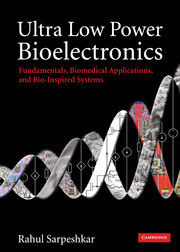Book contents
- Frontmatter
- Contents
- Acknowledgements
- Section I Foundations
- Section II Low-power analog and biomedical circuits
- Section III Low-power RF and energy-harvesting circuits for biomedical systems
- Section IV Biomedical electronic systems
- Section V Principles for ultra-low-power analog and digital design
- 21 Principles for ultra-low-power digital design
- 22 Principles for ultra-low-power analog and mixed-signal design
- Section VI Bio-inspired systems
- Section VII Energy sources
- Bibliography
- Index
- Epilogue
- References
21 - Principles for ultra-low-power digital design
from Section V - Principles for ultra-low-power analog and digital design
Published online by Cambridge University Press: 02 December 2010
- Frontmatter
- Contents
- Acknowledgements
- Section I Foundations
- Section II Low-power analog and biomedical circuits
- Section III Low-power RF and energy-harvesting circuits for biomedical systems
- Section IV Biomedical electronic systems
- Section V Principles for ultra-low-power analog and digital design
- 21 Principles for ultra-low-power digital design
- 22 Principles for ultra-low-power analog and mixed-signal design
- Section VI Bio-inspired systems
- Section VII Energy sources
- Bibliography
- Index
- Epilogue
- References
Summary
A small leak will sink a great ship.
Benjamin FranklinIn this chapter, we shall review important principles for ultra-low-power digital circuit and system design. We shall focus on operation with extremely low power-supply voltages and on subthreshold operation, although we shall provide some analysis of moderate-inversion and strong-inversion operation with the EKV model as well. As Chapter 6 on deep submicron effects in transistors discussed, because threshold voltages scale significantly less strongly than power-supply voltages, subthreshold operation is an increasingly dominant fraction of the voltage operating range. Subthreshold operation has become and will continue to get increasingly fast such that ultra-low-power operation in this regime does not sacrifice bandwidth in many applications. In biomedical and bioelectronic applications, subthreshold operation is ideal since bandwidth requirements are typically modest while energy efficiency is of paramount importance. An insightful paper by Meindl, that was way ahead of its time, pioneered subthreshold digital design. An analysis by Burr and Peterson analyzed the optimal energy efficiency of ultra-low-power subthreshold circuits. A more recent publication by Vittoz, the pioneer of subthreshold analog design, has analyzed issues in subthreshold digital design using his EKV model. Through such pioneering and other work, subthreshold digital design has been revived and is an active field of research in several academic and industrial institutions.
We shall begin by discussing the operation of a subthreshold CMOS inverter. Operation in the subthreshold regime is highly subject to transistor mismatch.
- Type
- Chapter
- Information
- Ultra Low Power BioelectronicsFundamentals, Biomedical Applications, and Bio-Inspired Systems, pp. 617 - 650Publisher: Cambridge University PressPrint publication year: 2010



